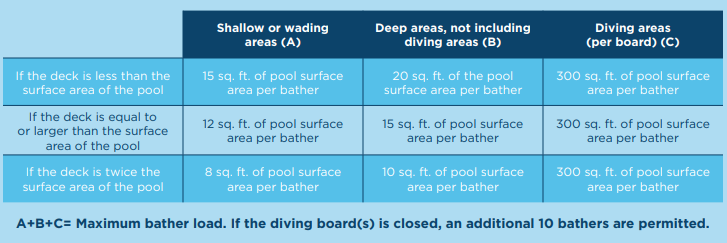Title Page
-
Client/Site
-
Date
-
Prepared by
-
Location
RECOMMENDATIONS FOR POOLS AND AQUATIC FACILITIES
COVID-19 RESPONSE RECOMMENDATIONS FOR POOLS AND AQUATIC FACILITIES Released May 5, 2020
-
In accordance with Governor Holcomb’s “Back On Track Indiana” plan, public/semi-public pools, spas, and similar aquatic venues may open at 50% their normal capacity when their respective Indiana counties move into Stage 3 of the plan. Major water parks are permitted to open at 50% capacity when a given county moves into Stage 4 of the plan. Please realize that local orders may be more restrictive, so pool owners/operators are advised to check with local health departments before opening.
There is no evidence that COVID-19 can be spread through pool water itself within properly maintained aquatic venues, according to the Centers for Disease Control and Prevention (CDC). The disinfectant (chlorine or bromine) should readily kill or inactivate the virus that causes COVID-19 as long as water chemistry and water circulation are adequate. It is of course necessary that disinfectant levels and related water chemistry be maintained in accordance with 410 IAC 6-2.1 to provide this degree of protection.
However, there are many opportunities for COVID-19 to spread directly between patrons in the deck area, pool enclosure, and sanitary facilities. Frequently touched surfaces allow for the transfer of infected respiratory droplets; the direct spread of droplets is possible if patrons are not adequately separated by six (6) feet or more. Enabling and promoting social distancing in an environment that is normally intended for somewhat crowded social interaction will require significant changes in how the facility is utilized. Reducing the bather load to 50% is only part of the solution. Furnishings within the deck area and pool enclosure will also need to be spaced and utilized differently. Frequently touched surfaces will need to be disinfected often using an effective disinfectant. -
Water Chemistry<br>It is critically important that minimum disinfectant levels (chlorine or bromine), a proper pH, and cyanuric acid (chlorine stabilizer) levels that do not exceed Indiana regulatory limits be maintained. This will allow for the rapid inactivation of viruses such as the one that causes COVID-19.<br><br>With adequate water circulation, proper water chemistry, regular water chemistry testing, and the continuous feed of an EPA-registered disinfectant (chlorine or bromine product), the pool/spa water itself can avoid becoming a mode of transmission for the coronavirus. Specific chemical parameters that are the most important for preventing the spread of viruses are as follows:<br>• Disinfectant level that meets the minimum level in 410 IAC 6-2.1-30(b). Depending on the type of pool and its relative risk, this level will be 1, 2, or 3 ppm<br>• A pH level within 7.2-7.8 is required. pH levels above 7.8 reduce chlorine’s effectiveness<br>• No cyanuric acid, CYA, chlorine stabilizer, ‘Trichlor,’ ‘Dichlor,’ chlorinated isocyanurates, trichloro-s-triazinetrione, or dichloro-s-triazinetrione should be utilized in any pool, spa, or other aquatic venues that are indoors. If such compounds are used in an outdoor venue, the cyanuric acid level must be tested weekly and maintained not to exceed 60 ppm. Excess cyanuric acid greatly reduces the disinfectant’s effectiveness<br><br>A more complete list of water chemistry regulations and testing requirements can be found within Section 30 of the Indiana State Department of Health’s “Public and Semi-Public Swimming Pools Rule” 410 IAC 6-2.1 at www.in.gov/isdh/files/410_iac_6_2_1.pdf.<br><br>As required by the above Indiana State Department of Health regulation, any aquatic venue with a disinfectant level outside of the acceptable range, a cyanuric acid level that is too high, a pH level above 8.0, or a chemical feeder or circulation pump that is not working should be immediately closed by the facility owner/operator until the problem is corrected.
-
Disinfecting Frequently Touched Surfaces<br>The virus that causes COVID-19 can survive on surfaces outside of the pool water for days without regular disinfection. Patrons may become infected by touching contaminated surfaces and then touching their own mouth, nose, or eyes. This presents one of the greatest concerns for COVID-19 transmission at pool and spa facilities.<br><br>Frequently touched objects such as those listed below are of particular concern and should be disinfected the most frequently.<br>• Doorknobs/handles (in the venue as well as in any building entryway doors)<br>• Stair railings and pool ladders<br>• Tables, deck chairs, and benches<br>• Light switches, keyless entry readers, and lockboxes<br>• Baby changing stations<br>• Drinking fountains<br>• Vending machines<br>• Telephones<br>• Any emergency shut-off controls (typically found on spas)<br>• Restroom faucets, sinks, soap and paper towel dispensers, toilet flush controls, and doors<br>• Touch-to-activate controls on interactive fountains and spa therapy jets<br>• Pool decks and the splash decks of interactive fountains<br><br>An EPA-registered disinfectant should be applied to such surfaces after removing any gross soil/dirt/grease/buildup in accordance with product label directions. It is important that gross soil/dirt be removed first for the disinfectant product to kill viruses effectively.<br><br>The Centers for Disease Control and Prevention (CDC) has provided information and instructions on how to disinfect similar surfaces at the following: www.cdc.gov/coronavirus/2019- ncov/prevent-getting-sick/cleaning-disinfection.html<br><br>A complete list of EPA-registered disinfectants suitable for coronavirus surface disinfection can be found at the following: www.epa.gov/pesticide-registration/list-n- disinfectants-use-against-sars-cov-2<br><br>Household bleach (approximately 6% active sodium hypochlorite) can also be diluted by mixing 1/3 cup with 1 gallon of water. Liquid pool chlorine is more concentrated (usually 10-12% sodium hypochlorite) and can be diluted by mixing 1/3 cup with 2 gallons of water. Bleach solutions should be mixed daily for use and discarded at the end of the workday. It is unnecessary and unsafe to use a dilution that is more concentrated. Chlorinated pool water is NOT adequate to serve as a surface disinfectant solution.<br><br>Appropriate personal protective equipment, such as chemical impermeable gloves, goggles, and/or a face shield should be utilized when working with all disinfectants in strict accordance with label directions and OSHA workplace standards.<br><br>Dependent on the type of disinfectant used (see label requirements), it may be necessary to disinfect some surfaces, such as the pool deck, when patrons are not present.<br><br>Consider implementing a system to gather and disinfect all deck chairs, kickboards, floats, etc. These items could then be signed out to incoming patrons for individual use. If it is not feasible to disinfect some items such as deck chairs between patrons (either due to time/staff constraints or because the items physically cannot be disinfected given materials and construction), it would be advisable to take such items out of use. Patrons could potentially be permitted to bring items such as lawn chairs from home.<br><br>Balls and any toys/games normally used for communal play (e.g. volleyball or water basketball) should be taken out of use.
-
50% Bather Load Reductions and Social Distancing<br>The virus that causes COVID-19 is understood to spread from person to person through small respiratory droplets that are emitted when a person coughs or sneezes. The facility owner/operator should implement all reasonable measures to promote, enable, and encourage social distancing between patrons from different households. Under no circumstances should lifeguards be required to enforce social distancing expectations because this could distract them from their life-saving surveillance duties.<br><br>The normally acceptable ‘bather load’ as calculated from the table in 410 IAC 6-2.1-7.5 is not adequate to promote a 6’ minimum spacing between patrons on the pool deck. Governor Holcomb’s “Back On Track Indiana” plan addresses this by requiring establishments such as public and semi-public pools to operate at no greater than at 50% their usual capacity.<br><br>This 50% bather load reduction should be maintained throughout Stages 3 and 4 of the Governor’s plan at pools, spas, and similar venues. Major water parks opening during Stage 4 must also operate at 50% the usual bather loads.
-
The established bather load determines how many people can be allowed inside of a given pool or aquatic venue enclosure (fenced area when outdoors; room when indoors) at one time. Bather load accounts for all of the people in the water as well as on the pool deck. The normal acceptable bather load can be calculated from the table below.
-
State code mandates that this normal bather load be posted on a sign with 1” letters. During Stages 3 and 4 of Governor Holcomb’s plan, this sign should be replaced or covered by a temporary sign stating the new 50% bather load.
Suggested measures that could be utilized to help limit the bather load at 50% while encouraging 6’ social distancing are listed below. Facility owners/operators should implement the combination of measures most appropriate for their unique operation.
• Access to the facility (gate/door) could be controlled by management or an attendant
• The total number of deck chairs/seats should be reduced to one half the usual number, not to exceed 50% the usual bather load
• Tables, benches, and deck chairs could be removed and/or appropriately spaced 6’ or more apart
• Deck chairs could be signed out to patrons with disinfection occurring between users
• A method to allow access for a limited block of time (i.e. 1.5 or 2 hours) may be implemented to allow more patrons access per day with the reduced bather load
• A system to reserve blocks of time could be implemented -
Face Coverings<br>Facility employees must wear face coverings when working near patrons or in areas accessible to patrons. Patrons should be encouraged or even required to wear face coverings when they are not actively swimming or in the water. This would apply to employees and patrons in deck areas, sanitary facilities, and other common use areas outside of the water. The CDC has recommended the use of face coverings to prevent the spread of respiratory droplets by patrons who are infected but not showing symptoms. Facility owners/operators could enforce this expectation via a variety of means, including signage, a waiver/ handout, or direct supervision by staff who are not actively serving as lifeguards.<br><br>Under no circumstances should lifeguards be taxed with additional surveillance/enforcement duties related to enforcing face-covering expectations.<br>Swimming with a face-covering could present a drowning hazard and should be prohibited.
-
Signage, Handouts, and/or Waivers
Specific COVID-19 relevant warnings could be presented to patrons in the form of signs, handouts, verbal instructions, or possibly even as a component of a waiver. Recommended statements that may be included in such a sign, handout, or waiver include, but are not limited to, the following: -
• DO NOT enter this facility if you have a cough, fever, or other symptoms of illness
-
• Maintain at least 6 feet between you and any other people who are not part of your immediate household
-
• Wear a face covering when you are not actively swimming or in the pool/spa water
-
• NEVER wear a face covering while actively swimming or allow children to do so
-
• NEVER dive or enter a water slide with a face covering in place
-
• The danger of contracting COVID-19 exists if you choose to enter this aquatic facility
-
• You are responsible for washing your hands as well as any objects you bring into this facility
-
Additional Resources and Information
For more information on preventing the spread of COVID-19 at public/semi-public aquatic facilities, please visit:
• The Centers for Disease Control and Prevention’s Coronavirus Webpage: https://www.cdc.gov/coronavirus/2019-ncov/index.html
• Pool and Hot Tub Alliance (PHTA)’s COVID-19 Webpage: https://www.phta.org/corona-test#1
• Indiana State Department of Health’s Public Swimming Pool and Spa Program: www.pools.isdh.in.gov
• The Pool Management Group’s “Pools Can Open Safely – COVID-19” Webpage: http://www.poolmanagementgroup.com/research/detail/pools_can_open_safely
• Water Parks Guidance: https://www.cdc.gov/coronavirus/2019-ncov/community/parks-rec/aquatic-venues.html
COMPLETION
-
Additional Notes
-
Sign Off

















